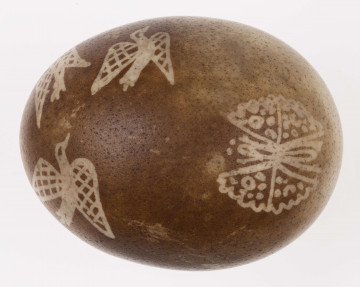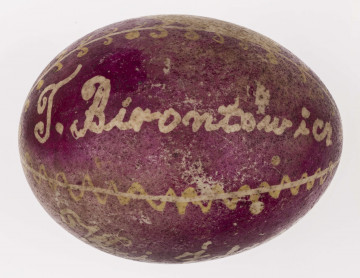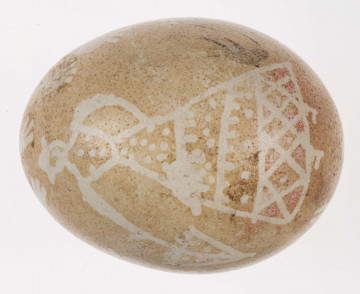
Easter egg
1901 — 1920
National Museum in Lublin
Part of the collection: Folk Art of the Lublin Region (17th–1st half of the 20th c.)
An Easter egg is an attribute of Easter. The egg was a symbol of life, fertility, love and strength, and the symbolism of ornaments written on it played an important magical role. In the Lublin region, eggs were most often decorated using the batik technique, which involved writing a design with melted wax using a marker made of sheet metal in the form of a funnel set on a stick (see E/1038/ML, E/1082/ML).
According to the type of ornaments, Lublin Easter eggs can be divided into two main groups: northern, where single-coloured pattern with straight lines prevails, and southern, with multi-coloured and numerous volute ornaments; in the central part of Lublin region influences of the groups intermingled and multi-coloured ornaments with straight lines occurred. Additionally, in the ornamentally rich southern group, depending on the area where the colours and motifs were applied, the following subgroups were distinguished: Biłgorajska, Zamojska, Hrubieszowska and Tomaszowska. The latter was characterised by a dark red or amaranth background with white and yellow ornaments or a black background with white, yellow and red ornaments; sometimes the background was violet or blue. Among the motifs, Russian influences are noticeable (the horseshoe motif or the girdle's gates). There often appeared human and animal figures, especially cockerel as a symbol of sun, spring and fertility, which sometimes with its stylised "peacock" tail resembled the "bird-feather" from Russian folk art.
In the ethnographic collection of the National Museum in Lublin there are about 2500 Easter eggs made by artists from the Lublin region. Most of them were made in the years 1950-1980, while a significant number (around 500), unfortunately of unknown authorship, date from the early 20th century. This Easter egg is one of the oldest.
Author / creator
Dimensions
cały obiekt: height: 4,8 cm
Object type
Easter egg
Technique
batik
Material
wax, egg, plant-based pigment,
Creation time / dating
Creation / finding place
Owner
The National Museum in Lublin
Identification number
Location / status

1901 — 1920
National Museum in Lublin

1901 — 1920
National Museum in Lublin

1901 — 1920
National Museum in Lublin
DISCOVER this TOPIC
Museum of King Jan III's Palace at Wilanów
DISCOVER this PATH
Educational path